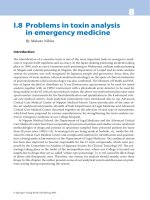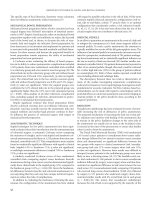Endocrine and Metabolic Emergencies - part 8 pdf
Bạn đang xem bản rút gọn của tài liệu. Xem và tải ngay bản đầy đủ của tài liệu tại đây (199.16 KB, 2 trang )
potentially life-threatening form of the disease, the clinical presentation is
one of an ill patient with symptoms and signs of adrenal insufficiency:
hypotension, tachycardia, hypoglycemia, extreme fatigue, and nausea and
vomiting. Also seen are failure to regrow shaved pubic hair, apathy, and
failure to lactate [30]. One should consider this diagnosis in obstetrical
patients with severe hemorrhage not responsive to blood replacement and
prolonged hypotension. This disease may be seen by emergency physicians
because of shorter postpartum hospitalizations.
In the chronic form, the clinical presentation may be seen from weeks to
years after delivery. The degree of hormone deficiency determines the
clinical presentation. The syndrome may be subclinical in some patients and
manifest only if the patient is stressed. Signs and symptoms may be vague
and nonspecific: lightheadedness, fatigue, failure to lactate, persistent
amenorrhea, decreased body hair, dry skin, loss of libido, nausea and
vomiting, and cold intolerance. DI has been reported in severa l cases of
Sheehan’s syndrome [8,38].
Pathophysiology
The pituitary gland lies in the sella turcica within the sphenoid bone [32].
The pituitary normally enlarges during pregnancy. The gland is comprised
of an anterior and posterior lobe, which are anatomically distinct [33]. The
blood supply to the anterior pituitary is through the internal carotid arteries
and superior hypophyseal arteries. The inferior hypophyseal arteries supply
the blood to the posterior pituitary. The anterior pituitary gland produces
six major hormones: prolactin (PRL), growth hormone (GH), corticotropin
(ACTH), luteinizing hormone (LH), follicle stimulating hormone (FSH),
and thyroid stimulating hormone (TSH). The posterior pituitary gland
produces ADH and oxytocin.
The pathogenesis of Sheehan’s syndrome is not understood fully. During
pregnancy, the normal pituitary enlarges, predominantly because of pro-
gressive lactotroph hyperplasia.
Based on extensive pathologic studies of patients, Sheehan proposed
pituitary necrosis caused by occlusive spasm of the pituitary vessels. The size
of the necrosis depends on the severity, duration, and distribution of the
spasm. Massive or submassive ischem ic necrosis of the pituitary gland
should result in acute pituitary failure; however, delayed presentation of
pituitary failure is common, with patients presenting years later with
symptomatology. This slow clinical progression has led some authors to
suggest a relationship between postpartum hemorrhage, pituitary anti-
bodies, and the development of Sheehan’s syndrome [34–36].
Differential diagnosis
Sheehan’s syndrome should be considered in the patient with a recent
obstetrical delivery with findings of shock. The differential diagnosi s
837EXTERNAL CAUSES OF METABOLIC DISORDERS
The Emergency Department Approach
to Newborn and Childhood
Metabolic Crisis
Ilene Claudius, MD, Colleen Fluharty, MD
*
,
Richard Boles, MD
Department of Emergency and Transport Medicine,
Children’s Hospital Los Angeles, 4650 Sunset Boulevard,
MS113, Los Angeles, CA 90027, USA
For most emergency medicine physicians, the phrases ‘‘newborn
workup’’ and ‘‘metabolic disease’’ are, at best, uncomfortable. This article,
however, provides a simple approach to the recognition, evaluation, and
treatment of infants with all manners of metabolic issues, including
hypoglycemia, inborn errors of metabolis m, jaundice, and electrolyte
abnormalities. The disorders are grouped based on symptomatology, and
have simple guidel ines for work-up and management, with an emergency
department practitioner perspective in mind.
The workup of a newborn with metabolic disease in the emergency
department (ED) is a daunting endeavor for any physician. This article
provides a simple approach to the recognition, evaluation, and treatment of
infants with all manner of metabolic issues, including hypoglycemia, inborn
errors of metab olism, jaundice, and electrolyte abnormalities.
Hypoglycemia
Definition
For years, the definition of hypoglycemia in neonates has varied widely,
with some authors accepting a blood glucose of 30 mg/dL, while other
sources change thresholds as an infant progresses through the first few days
of life. More recently, neonatologists have accepted plasma glucose levels
!45 mg/dL as a clear indication of hypoglycemia in any symptomatic
* Corresponding author.
E-mail address: (C. Fluharty).
0733-8627/05/$ - see front matter Ó 2005 Elsevier Inc. All rights reserved.
doi:10.1016/j.emc.2005.03.010 emed.theclinics.com
Emerg Med Clin N Am 23 (2005) 843–883









